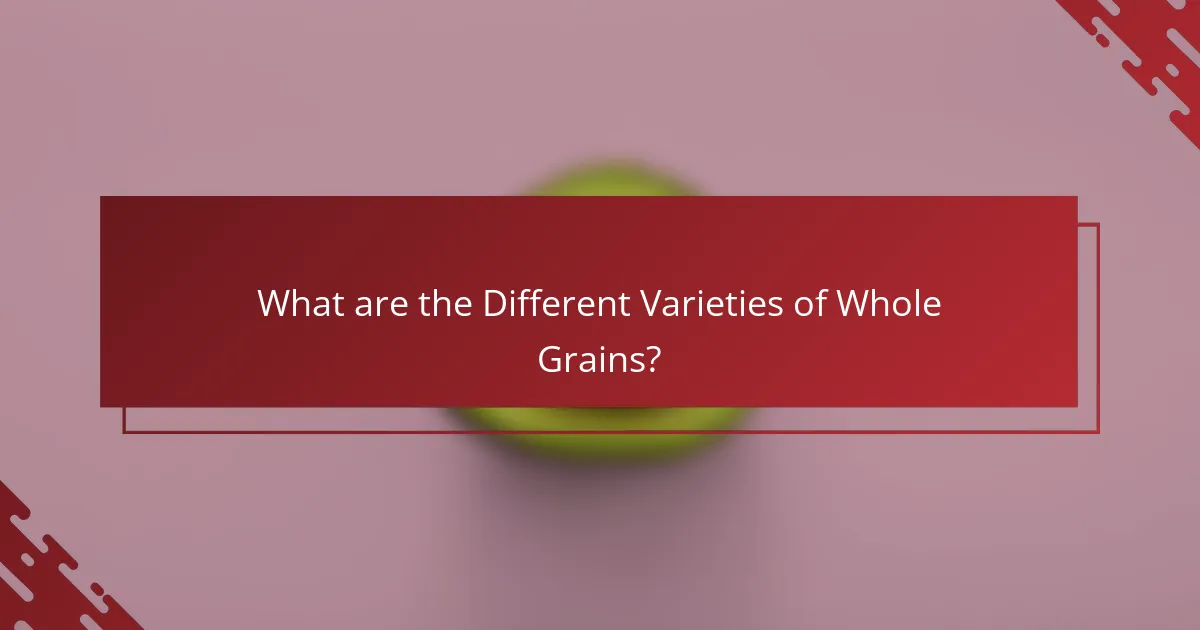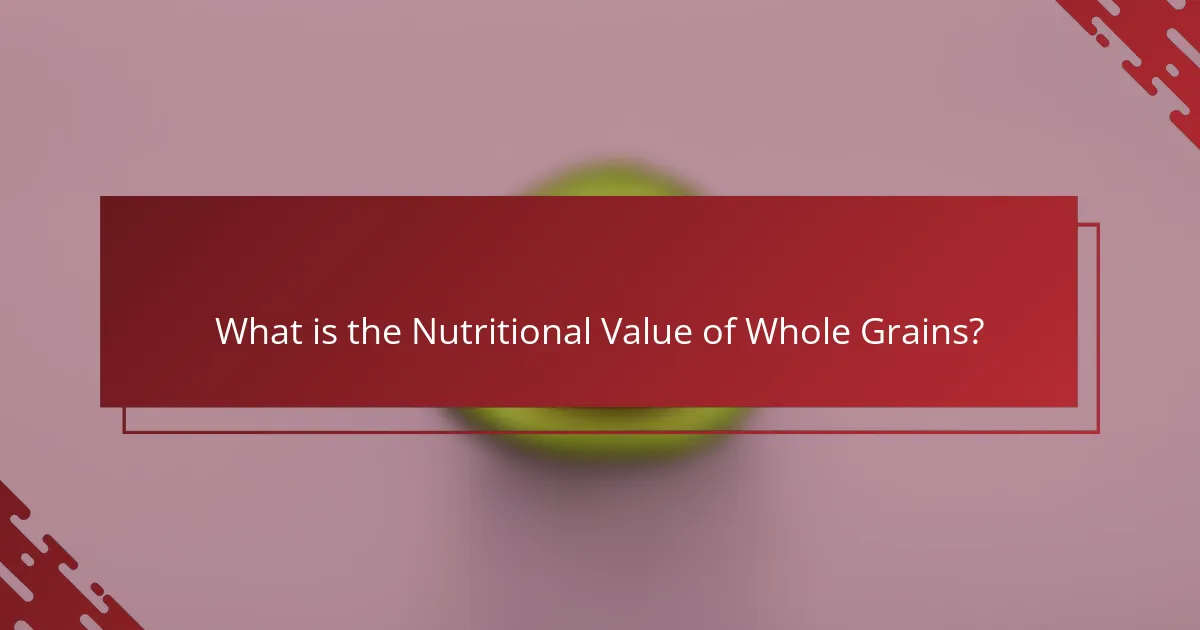Whole grains are cereal grains that include all components of the grain kernel: bran, germ, and endosperm. They are rich in essential nutrients such as fiber, B vitamins, iron, magnesium, and antioxidants, contributing to various health benefits, including improved digestion, weight management, and a reduced risk of chronic diseases like heart disease and type 2 diabetes. Common varieties of whole grains include brown rice, quinoa, barley, oats, and whole wheat, each offering unique nutritional advantages. Cooking methods such as boiling, steaming, and baking are effective for preparing whole grains while preserving their nutritional value. This article explores the benefits of whole grains, their nutritional content, and recommended cooking techniques.

What are Whole Grains and Why are They Important?
Whole grains are cereal grains that contain all parts of the grain kernel. This includes the bran, germ, and endosperm. Whole grains are important because they provide essential nutrients and health benefits. They are high in fiber, which aids digestion and helps maintain a healthy weight. Research shows that whole grain consumption is linked to a lower risk of heart disease, type 2 diabetes, and certain cancers. The Dietary Guidelines for Americans recommend making at least half of all grain intake whole grains. Whole grains also contain important vitamins and minerals, such as B vitamins, iron, magnesium, and antioxidants.
How do Whole Grains differ from Refined Grains?
Whole grains contain all parts of the grain kernel, including the bran, germ, and endosperm. Refined grains, on the other hand, have been processed to remove the bran and germ. This process results in a loss of fiber, vitamins, and minerals. Whole grains provide more nutrients and health benefits compared to refined grains. For instance, whole grains can reduce the risk of heart disease and diabetes. In contrast, refined grains can lead to spikes in blood sugar levels. Studies show that diets high in whole grains are associated with lower body weight and improved digestion.
What components make up Whole Grains?
Whole grains consist of three main components: the bran, the germ, and the endosperm. The bran is the outer layer that provides fiber and essential nutrients. The germ is the nutrient-rich core that contains vitamins, minerals, and healthy fats. The endosperm is the starchy part that serves as the primary energy source. Together, these components contribute to the nutritional value of whole grains. Whole grains retain all parts of the grain kernel, unlike refined grains, which remove the bran and germ. This retention enhances their health benefits, including improved digestion and reduced risk of chronic diseases.
Why is the bran, germ, and endosperm significant?
The bran, germ, and endosperm are significant because they make up the three key components of whole grains. The bran is the outer layer, rich in fiber and essential minerals. It contributes to digestive health and helps regulate blood sugar levels. The germ is the nutrient-rich core, containing vitamins, healthy fats, and antioxidants. It plays a crucial role in overall health and disease prevention. The endosperm is the starchy middle layer, providing energy and carbohydrates. Together, these components offer a balanced nutritional profile. Whole grains containing all three parts have been linked to reduced risk of chronic diseases, such as heart disease and diabetes. Studies show that consuming whole grains can improve heart health and lower cholesterol levels.
What are the Health Benefits of Consuming Whole Grains?
Whole grains provide numerous health benefits. They are rich in dietary fiber, which aids digestion and helps maintain a healthy weight. Consuming whole grains can lower the risk of heart disease by reducing cholesterol levels. They also help regulate blood sugar levels, making them beneficial for diabetes management. Whole grains contain essential nutrients like B vitamins, iron, magnesium, and antioxidants. Studies show that eating whole grains is associated with a lower risk of stroke and certain cancers. For instance, a study published in the American Journal of Clinical Nutrition found that individuals who consume whole grains regularly have a 20-30% lower risk of cardiovascular disease.
How do Whole Grains contribute to heart health?
Whole grains contribute to heart health by reducing the risk of cardiovascular diseases. They contain high levels of dietary fiber, which helps lower cholesterol levels. A study published in the Journal of the American College of Cardiology found that consuming whole grains is linked to a 25% lower risk of heart disease. Whole grains also provide essential nutrients like magnesium and antioxidants. These nutrients help maintain healthy blood pressure and reduce inflammation. Regular consumption of whole grains can improve overall heart health and promote longevity.
What role do Whole Grains play in weight management?
Whole grains play a significant role in weight management. They are high in fiber, which promotes satiety and reduces overall calorie intake. Consuming whole grains can lead to lower body weight and a reduced risk of obesity. A study published in the American Journal of Clinical Nutrition found that individuals who consumed whole grains had a lower risk of weight gain compared to those who consumed refined grains. Whole grains also have a lower glycemic index, which helps regulate blood sugar levels and control hunger. This combination of factors makes whole grains an effective choice for those looking to manage their weight.
How can Whole Grains affect digestive health?
Whole grains positively affect digestive health by providing dietary fiber. This fiber aids in regular bowel movements and prevents constipation. Whole grains contain both soluble and insoluble fiber. Soluble fiber helps to soften stool, making it easier to pass. Insoluble fiber adds bulk to stool, promoting movement through the digestive tract. Studies show that high fiber intake is linked to a lower risk of digestive disorders. For example, a study published in the American Journal of Clinical Nutrition found that individuals consuming whole grains had a significantly lower incidence of diverticulitis. Overall, whole grains support a healthy digestive system through their fiber content.

What are the Different Varieties of Whole Grains?
Whole grains include various types such as brown rice, quinoa, barley, oats, and whole wheat. Each variety retains its bran, germ, and endosperm, which contribute to their nutritional value. Brown rice is a popular whole grain that is rich in fiber and essential nutrients. Quinoa is gluten-free and contains all nine essential amino acids. Barley is known for its high fiber content and can aid in digestion. Oats are often consumed as oatmeal and are beneficial for heart health. Whole wheat flour is commonly used in baking and provides more nutrients compared to refined flour. These whole grains offer a range of health benefits, including improved digestion, weight management, and reduced risk of chronic diseases.
What are some common types of Whole Grains?
Common types of whole grains include brown rice, quinoa, barley, oats, and whole wheat. Brown rice is unrefined and retains its bran and germ. Quinoa is a gluten-free grain that is high in protein. Barley is rich in fiber and has a chewy texture. Oats are often consumed as oatmeal and are known for their heart health benefits. Whole wheat is used in various baked goods and retains all parts of the grain. These grains provide essential nutrients and are a healthier alternative to refined grains.
How does Brown Rice compare to Quinoa?
Brown rice and quinoa are both nutritious whole grains. Brown rice is a good source of carbohydrates and fiber. It contains about 3.5 grams of fiber per cooked cup. Quinoa, on the other hand, is a complete protein, providing all nine essential amino acids. It has approximately 5 grams of fiber per cooked cup.
In terms of minerals, brown rice is higher in magnesium, while quinoa offers more iron and potassium. Brown rice typically has a chewy texture and nutty flavor. Quinoa has a slightly crunchy texture and a mild, earthy taste.
Cooking times differ; brown rice takes about 45 minutes to cook, while quinoa cooks in about 15 minutes. Both grains can be used in various dishes, but quinoa is often considered more versatile due to its protein content.
What are the nutritional differences between Barley and Oats?
Barley and oats have distinct nutritional profiles. Barley contains approximately 354 calories per 100 grams. It has 12.5 grams of protein, 73.5 grams of carbohydrates, and 17.3 grams of dietary fiber. Oats, on the other hand, have about 389 calories per 100 grams. They provide 16.9 grams of protein, 66.3 grams of carbohydrates, and 10.6 grams of dietary fiber.
In terms of vitamins, barley is rich in B vitamins, particularly niacin and thiamine. Oats also contain B vitamins but are especially high in vitamin E. When comparing minerals, barley has higher levels of iron and magnesium than oats. Oats provide more phosphorus and potassium compared to barley.
Both grains contain beta-glucans, which are beneficial for heart health. However, oats have a higher concentration of these soluble fibers. This difference contributes to oats being more effective in lowering cholesterol levels. Overall, both grains offer unique nutritional benefits that can complement a balanced diet.
How can I incorporate Whole Grains into my diet?
Incorporate whole grains into your diet by replacing refined grains with whole grain options. Choose whole grain bread, pasta, and rice instead of white varieties. Add whole grains like quinoa, barley, or farro to salads and soups for added texture and nutrition. Start your day with whole grain cereals or oatmeal for breakfast. Snack on popcorn or whole grain crackers instead of chips. Baking with whole grain flour can enhance the nutritional profile of your baked goods. Research shows that whole grains can lower the risk of heart disease and improve digestive health. The Whole Grains Council states that consuming at least three servings of whole grains daily is beneficial for overall health.
What are some easy recipes using Whole Grains?
Quinoa salad is an easy recipe using whole grains. Combine cooked quinoa with diced vegetables like cucumbers and bell peppers. Add olive oil, lemon juice, salt, and pepper for flavor. This dish is nutritious and rich in protein.
Brown rice stir-fry is another simple option. Sauté vegetables such as broccoli, carrots, and bell peppers in a pan. Add cooked brown rice and soy sauce for seasoning. This meal is quick and filling.
Oatmeal is a classic whole grain recipe. Cook rolled oats with water or milk on the stovetop. Top with fruits like bananas or berries and a drizzle of honey. Oatmeal is high in fiber and helps with digestion.
Whole grain pasta with marinara sauce is also easy to prepare. Boil whole grain pasta until al dente. Heat marinara sauce and combine with the pasta. This dish is a good source of complex carbohydrates.
These recipes showcase the versatility and health benefits of whole grains. They are simple to make and packed with nutrients.
How can I replace refined grains with Whole Grains in meals?
Replace refined grains with whole grains by choosing whole grain alternatives. Use brown rice instead of white rice. Opt for whole grain bread instead of white bread. Select whole wheat pasta over regular pasta. Incorporate quinoa or barley as sides instead of refined grains. Use oats for breakfast instead of sugary cereals. Read labels to ensure products are 100% whole grain. Whole grains retain nutrients and fiber, promoting better health outcomes. Studies show whole grains reduce the risk of heart disease and diabetes.

What is the Nutritional Value of Whole Grains?
Whole grains are rich in essential nutrients. They provide fiber, vitamins, and minerals. A typical serving of whole grains contains approximately 3-6 grams of dietary fiber. This fiber aids in digestion and helps maintain a healthy weight. Whole grains are also a good source of B vitamins, including thiamin, riboflavin, and niacin. These vitamins play a crucial role in energy metabolism. Additionally, whole grains contain important minerals such as iron, magnesium, and selenium. For example, 100 grams of brown rice offers about 2.6 mg of iron and 43 mg of magnesium. Whole grains can reduce the risk of chronic diseases, including heart disease and diabetes, according to studies published in the American Journal of Clinical Nutrition.
What vitamins and minerals are found in Whole Grains?
Whole grains contain essential vitamins and minerals. They are rich in B vitamins, including thiamine, riboflavin, niacin, and folate. Whole grains also provide vitamin E, an important antioxidant. Minerals found in whole grains include iron, magnesium, zinc, and selenium. These nutrients play crucial roles in metabolism and overall health. For example, magnesium supports muscle function and heart health. Iron is vital for oxygen transport in the blood. The presence of these vitamins and minerals makes whole grains a valuable component of a balanced diet.
How do Whole Grains contribute to daily fiber intake?
Whole grains significantly contribute to daily fiber intake. They contain both soluble and insoluble fiber. Soluble fiber helps lower cholesterol and regulate blood sugar levels. Insoluble fiber aids in digestion and promotes regular bowel movements. A serving of whole grains typically provides 3 to 8 grams of fiber. The Dietary Guidelines recommend 25 grams of fiber daily for women and 38 grams for men. Consuming whole grains can help individuals meet these daily fiber recommendations. Examples include oats, brown rice, and whole wheat bread. These foods not only enhance fiber intake but also provide essential nutrients.
What is the protein content in various Whole Grains?
Whole grains generally contain varying amounts of protein. For example, quinoa has about 8 grams of protein per cooked cup. Brown rice offers approximately 5 grams of protein per cooked cup. Barley contains around 3.5 grams of protein per cooked cup. Oats provide about 6 grams of protein per cooked cup. Whole wheat pasta has roughly 7 grams of protein per cooked cup. Millet contributes around 6 grams of protein per cooked cup. These values demonstrate the protein content found in common whole grains, highlighting their nutritional benefits.
How does the cooking method affect the nutritional value of Whole Grains?
Cooking methods significantly influence the nutritional value of whole grains. Different techniques can alter the levels of vitamins, minerals, and fiber. For instance, boiling can lead to nutrient loss in water-soluble vitamins. Steaming, however, retains more nutrients compared to boiling. Roasting may enhance flavor but can also reduce some antioxidant levels. Cooking time and temperature affect nutrient bioavailability. Whole grains cooked at high temperatures may form harmful compounds. Therefore, the method of cooking is crucial for maximizing the health benefits of whole grains.
What are the best cooking methods for preserving nutrients?
Steaming and microwaving are the best cooking methods for preserving nutrients. These methods minimize nutrient loss compared to boiling or frying. Steaming retains vitamins and minerals effectively, as food is cooked quickly without direct contact with water. Research indicates that steaming can preserve up to 90% of nutrients. Microwaving also uses short cooking times and minimal water, leading to less nutrient degradation. Studies show that microwaving can maintain 80-90% of vitamin C in vegetables. Using these methods enhances the nutritional value of whole grains and vegetables significantly.
How does soaking or sprouting Whole Grains impact their health benefits?
Soaking or sprouting whole grains enhances their health benefits significantly. Soaking reduces anti-nutrients like phytic acid, which can inhibit mineral absorption. This process increases the bioavailability of nutrients such as iron, zinc, and calcium. Sprouting further activates enzymes that break down complex carbohydrates, making them easier to digest. It also boosts protein content and enhances the levels of vitamins, particularly B vitamins. Studies show that sprouted grains can have up to 30% more nutrients than unsprouted grains. Additionally, soaking and sprouting can improve the flavor and texture of whole grains, making them more palatable. These methods ultimately contribute to a healthier diet by increasing nutrient intake and digestibility.

What Cooking Methods are Best for Whole Grains?
Boiling, steaming, and baking are the best cooking methods for whole grains. Boiling involves cooking grains in water until tender, which helps retain nutrients. Steaming preserves more vitamins compared to boiling. Baking, such as in casseroles, allows for even cooking and flavor enhancement. Each method ensures whole grains maintain their nutritional value. Cooking times may vary; for example, brown rice typically takes 40-50 minutes to cook. The choice of method can also affect texture; steaming yields a firmer grain, while boiling can produce a softer texture.
How can I prepare Whole Grains effectively?
To prepare whole grains effectively, rinse them under cold water to remove debris. Then, soak grains like barley or quinoa for several hours to reduce cooking time. Use a ratio of two parts water to one part grain for most varieties. Bring the water to a boil, then add the grains. Reduce heat and simmer until the grains are tender. Cooking times vary; for example, brown rice takes about 45 minutes, while quinoa cooks in 15 minutes. Fluff the grains with a fork after cooking to enhance texture. Whole grains retain more nutrients when cooked properly, providing health benefits.
What are the differences between boiling, steaming, and baking Whole Grains?
Boiling, steaming, and baking whole grains are distinct cooking methods that affect texture and flavor. Boiling involves submerging grains in water, leading to a softer texture. This method often results in a stickier consistency, making it suitable for dishes like porridge. Steaming uses vapor to cook grains, preserving more nutrients and providing a firmer texture. This method is ideal for retaining the natural flavors of the grains. Baking involves cooking grains in an oven, often combined with other ingredients. This method can create a crispy exterior and a chewy interior, enhancing the overall flavor profile. Each method influences the final dish’s nutritional value and taste, making the choice dependent on desired outcomes.
How can I use a pressure cooker for Whole Grains?
To use a pressure cooker for whole grains, start by rinsing the grains thoroughly. This removes any debris and helps improve texture. Next, add the rinsed grains to the pressure cooker along with the appropriate amount of water. The typical ratio is 1 part grains to 2-3 parts water, depending on the grain type. Close the lid securely and set the pressure cooker to high pressure. Cook for the recommended time, which varies by grain; for example, brown rice takes about 22-25 minutes. After cooking, allow the pressure to release naturally for optimal texture. Whole grains cooked this way retain more nutrients and flavor compared to traditional methods.
What tips can I follow for cooking Whole Grains?
Rinse whole grains thoroughly before cooking to remove dust and impurities. This step ensures better flavor and texture. Soaking grains for several hours or overnight can reduce cooking time. For most grains, use a water-to-grain ratio of about 2:1. Bring water to a boil before adding grains for optimal cooking. Lower the heat and cover the pot to simmer. Cooking times vary; for example, brown rice takes about 45 minutes, while quinoa cooks in 15 minutes. Allow grains to rest covered off the heat for 5-10 minutes after cooking. Fluff with a fork before serving to enhance texture.
How can I ensure Whole Grains are cooked to perfection?
To ensure whole grains are cooked to perfection, start by rinsing them thoroughly to remove any debris. Use the correct water-to-grain ratio, typically 2 to 1 for most whole grains. Bring the water to a boil before adding the rinsed grains. Reduce heat to low and cover the pot to simmer. Cooking times vary; for example, brown rice takes about 45 minutes, while quinoa cooks in 15 minutes. Stir occasionally to prevent sticking. Once cooked, let the grains sit covered for 5 to 10 minutes to absorb remaining moisture. Fluff with a fork before serving to enhance texture. Proper cooking enhances flavor and maximizes nutritional benefits.
What common mistakes should I avoid when cooking Whole Grains?
Common mistakes to avoid when cooking whole grains include not rinsing them before cooking. Rinsing removes excess starch and prevents stickiness. Another mistake is using insufficient water. Whole grains require more water than white rice or pasta. Failing to soak grains can lead to longer cooking times and uneven texture. Not adjusting cooking times for different grain types is also common. Each grain has its own ideal cooking duration. Additionally, neglecting to season the cooking water can result in bland grains. Finally, overcooking can destroy nutrients and alter texture. Properly cooking whole grains enhances their flavor and nutritional benefits.
Whole grains are cereal grains that retain all parts of the grain kernel, including the bran, germ, and endosperm, providing essential nutrients and health benefits. This article explores the importance of whole grains, highlighting their role in reducing the risk of chronic diseases such as heart disease and diabetes, and their contributions to digestive health and weight management. It also compares whole grains to refined grains, outlines various types and their nutritional values, and discusses effective cooking methods to maximize their health benefits. Key components, such as dietary fiber, vitamins, and minerals found in whole grains, are emphasized, along with practical tips for incorporating them into daily meals.